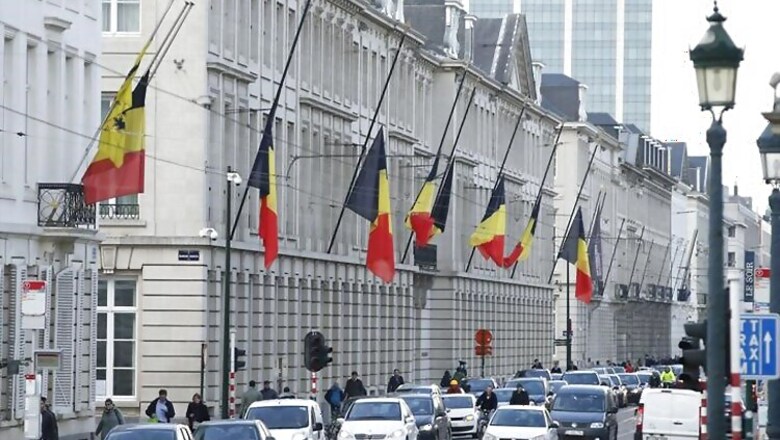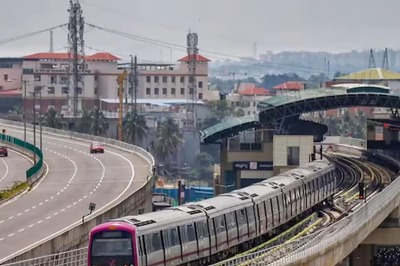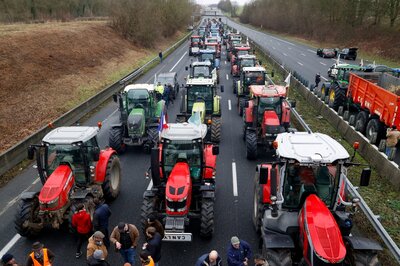
views
Baarle-Hertog-Nassau: With the border dividing the Netherlands and Belgium cutting straight through the entrance of her studio and art gallery, Sylvia Reijbroek was confused over which country’s rules to follow when the coronavirus upended Europe.
Playing it safe, Reijbroek decided to follow Belgian law, since her gallery is legally registered there, and she closed down her business. But it has been frustrating, she said, seeing customers walking in and out of the health and beauty care shop right next door — in the Netherlands.
“There is only one shop on this street that had to adhere to Belgian law and closed,” she said sourly. “Mine.”
As European countries begin to ease their restrictions on public life at a varied pace, with some allowing businesses to reopen while others remain on lockdown, the different rules are sowing confusion for travelers and the many people who live in border areas and regularly cross back and forth.
And nowhere, it seems safe to say, are these divergent strategies more visible and perplexing than in the border-straddling town of Baarle-Hertog-Nassau, where the rules can differ from street to street, door to door and even within buildings, with Dutch law in force in one spot and Belgium’s applied just a few steps away.
Baarle-Hertog-Nassau is often referred to as the world’s most complex border situation, and it is hard to argue the point. The town sits several miles inside the Netherlands, but owing to a deal hammered out between feudal lords in 1198, it is divided roughly evenly into two sides, Belgian and Dutch.
But that is just the beginning of the puzzle. Within each side are enclaves belonging to the other — 22 Belgian enclaves in the Dutch side and eight Dutch enclaves in the Belgian side, leading to a dizzying mishmash of border markings.
Each enclave is subject to its nation’s laws, creating a patchwork of conflicting rules and regulations — but “without the unrest and strife often associated with enclaves,” said Willem van Gool, a local tourism official.
While there is peace on both sides of the many borders, that doesn’t mean the situation was easy to manage even under normal circumstances. With the coming of the coronavirus, Reijbroek said, it became “absurd.”
Belgium, one of the hardest-hit countries in Europe, went into total lockdown in March, issuing fines to anyone who ventured from home without a good reason.
But the Netherlands took a far more relaxed approach, allowing takeout restaurants, retail shops and government offices to remain open and people to roam the streets. The government asked only that people stay at home as much as possible and maintain social distancing practices when outside.
In Baarle-Hertog-Nassau, those conflicting visions made everyday life confounding for its 11,000 residents of both nationalities.
“We follow the Belgian law, so we closed all stores in our areas,” said Frans de Bont, the mayor of Baarle-Hertog, the Belgian part of town. “We hoped that the Dutch would follow our policy, or at least that they would follow our policies inside this mixed town.”
They did not.
The Belgian government responded to the outbreak by sealing off all crossings along the 280-mile border with the Netherlands. Long-forgotten checkpoints suddenly reappeared as police blocked anyone from entering and leaving. Dutch people accustomed to crossing into Belgium for cheaper gasoline were disappointed. In the confusion of the first days, some families found themselves suddenly separated, but subsequently allowances were made for family visits across the border.
In and around Baarle-Hertog-Nassau, however, such closures were physically and psychically impossible.
“We have had attempts in the past using chicken wire, but that didn’t really work,” explained van Gool, chair of the local tourism office, which is shared by both sides. “There would be wires everywhere, crisscross around the city.”
So inside the mixed town all stores on the Dutch side remained open, with Dutch customers cheerfully buying fries and ice cream while the Belgians sat frowning behind the windows of their houses.
Reijbroek’s gallery business was not the only one literally caught in the middle. Down the street, a Zeeman’s outlet, part of a chain known in both countries for cheap clothing, was cut in half by one of the enclaves’ borders.
The Belgian side of the store was blocked off, first with red and white tape and later by store shelves filled with chocolates and toys. Customers looking for underwear were out of luck, one sales clerk explained, “because their shelves are in Belgium.”
“This is what makes our town so interesting,” said van Gool cheerfully.
It wasn’t always so. Through the centuries, the two sides had worked out a modus vivendi, with inhabitants of the enclaves given right of passage so that, for example, Reijbroek can live in her apartment on the other side of the street, in the Netherlands.
Van Gool said there is a special governmental arrangement allowing the two local administrations to streamline decisions concerning new roads and cultural events.
“We are an example for Europe,” van Gool insisted, saying that despite cultural differences, decisions are made with respect for each other. “Here in Baarle, we always find a way forward.”
This week, several European countries began easing their coronavirus restrictions, with governments trying to placate their restless populations and reboot stalled economies without creating opportunities for disease to spread.
Across the continent, schools and airports are opening; and restaurants, hairdressers and other small business are being allowed to open their doors.
Baarle-Hertog-Nassau is ready for an easing of restrictions, having fared well in the epidemic: just two deaths of older people on the Dutch side, and eight confirmed cases and no deaths on the Belgian.
On Monday, Belgium took a cautious first step away from its intense lockdown by fully restarting public transportation services. Under the new rules face masks are obligatory while traveling, on penalty of a fine of 250 euros, about $270.
But in the neighboring Netherlands, politicians have been critical of the use of face masks.
Trying to avoid confusion, the Belgian mayor, de Bont, was busy last week preparing his citizens for the new rules on masks.
“When you take the bus from Turnhout inside Belgium toward here, you have to wear it,” he said. “But when you arrive on Dutch soil you can take it off. That is a bit strange.”
Thomas Erdbrinkc.2020 The New York Times Company


















Comments
0 comment